Is It Time for the NBA to Bubble Up?

Last month, on a conference call with reporters to discuss the start of the season, I asked Adam Silver about the NBA’s fallback plans—specifically, a return to a similar bubble-like environment that allowed the league to safely complete the 2019–20 season—should the COVID-19 pandemic become too disruptive.
“As you might imagine, we have lots of alternative plans in the drawers,” Silver said. “Depending on how this goes, we’ll look at other alternatives if we need to.”
The NBA might need to.
The last week has been among the league’s most paralyzing. Four players tested positive for COVID-19, but that was just the tip of the iceberg. Kevin Durant—who tested positive last March—was sidelined because of the NBA’s health and safety protocols which, translated, means contact tracing determined that Durant was exposed to someone with the virus. The Celtics frontcourt was gashed on Friday when Tristan Thompson and Grant Williams were pulled for the same reason. Philadelphia barely scraped together the minimum eight players on Saturday after Seth Curry’s positive diagnosis wreaked havoc on the roster.
“The last 36 hours have been nuts,” said Sixers coach Doc Rivers. “I don’t think we should [play]. I do worry about our player health on the floor.”
None of this is the NBA’s fault, of course. A return to an Orlando-like bubble for a full season was unrealistic, as both Silver and NBPA chief Michele Roberts have indicated. The league has implemented thorough protocols that do everything possible to keep players safe. Recently, the NBA required players to wear sensors to assist with contact tracing.
There has been some confusion. How the NBA defines “close contact” is one area. Following the lead of the Center for Disease Control, the league defines close contact as being within six feet of a COVID-positive person for at least 15 minutes. That means players who test positive are not identified as being in close contact with opponents. In Washington, where the Wizards’ last two games were against Philadelphia (a game Curry played 36 minutes in) and Boston (where Jayson Tatum, who will reportedly miss 10-14 days, a timeline associated with a positive test, played 35 minutes), some team officials wondered why there wasn’t a pause in the schedule to sort everything out.
Still—this is a contagious virus.
There’s only so much the NBA—or anyone—can do to keep it at bay.
The NBA isn’t panicking over the results of this week. The league fully anticipated positive tests, which Silver emphasized on the call with reporters. And January was expected to be among the toughest months, with the league feeling the fallout from the Christmas holiday.
But what happens if the next few weeks look a lot like this one?
What happens if the integrity of the regular season is further compromised?
When is it time to bubble up?
Getting owners on board with another bubble could be challenging. “They don’t want to pay for it,” a high-ranking team executive told SI. Indeed, the cost of the Orlando bubble was in the neighborhood of $180 million. While the majority of teams are not bringing in gate revenue, the appetite for forking over millions to rebuild a secure environment is expected to be minimal.
And the NBA believes things could get better. The hope—and that’s all it is at this point—is that the more distance the calendar gets from the holidays, the safer it will be. The increased distribution of a COVID vaccine should progressively reduce the need for contact tracing, and there is optimism that by the spring, vaccines could become available enough that players and coaches could start receiving it.
But these are all unknowns. It’s worth noting that the NBA will have the infrastructure in place for a bubble The league announced this week that the G-League will play its season in a Disney bubble. In February, 18 teams will call Lake Buena Vista, Fla. home for a season that is expected to last around a month. There is also a growing number of team officials who believe, regardless of a bubble, that the NBA should consider a weeklong pause of the season.
“It’s f------ crazy right now,” an NBA coach told SI. “Honestly, we go to work every day wondering who is going to be available.”
The NBA should consider a return to a bubble, if only for self-preservation. For years the league has worked to make sure star players were available for high-profile games. Durant was sidelined for last Thursday’s nationally televised game against Philadelphia. Tatum could miss two ESPN-televised games against Philadelphia if he is forced to sit out a full two weeks. Television ratings—something the NBA keeps a close eye on—could suffer.
A bubble doesn’t solve everything. But it’s been proven to allow the league to safely finish a season. It’s not ideal. But it may be what’s left.

Chris Mannix is a senior writer at Sports Illustrated covering the NBA and boxing beats. He joined the SI staff in 2003 following his graduation from Boston College. Mannix is the host of SI's "Open Floor" podcast and serves as a ringside analyst and reporter for DAZN Boxing. He is also a frequent contributor to NBC Sports Boston as an NBA analyst. A nominee for National Sportswriter of the Year in 2022, Mannix has won writing awards from the Boxing Writers Association of America and the Pro Basketball Writers Association, and is a longtime member of both organizations.
Follow sichrismannix